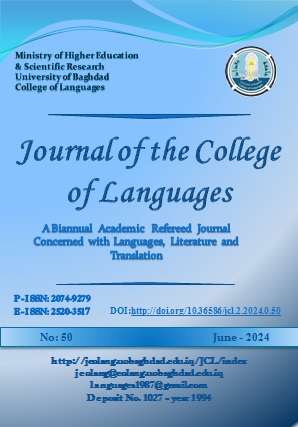Tautology and Pleonasm in Political Interviews: A Semantic study
DOI:
https://doi.org/10.36586/jcl.2.2024.0.50.0059Keywords:
tautology, pleonasm, political interviews, redundancyAbstract
Pleonasm refers to the involvement of unnecessary words or morphemes represents pleonastic words which repeat a mentioned information elsewhere, whereas tautology refers to the inacceptable repetition of the same ideas, words, or phrases by using diverse words. In English, there is a perplexity to distinguish some elements that may be misled to be regarded as pleonastic or tautological. The current study aims at analysing two political interviews in the light of pleonasm and tautology concepts and find out the differences between them semantically. The data analysis is taken from two presidential interviews for the American presidents Trump and Biden in 2020. The study has concluded that tautology and pleonasm can be used in disparate degrees in political speeches. Using tautology is more necessary than pleonasm in political speeches, in which pleonasm concentrates on ideas and implied meaning, which can be misled to simple, ordinary people, while tautology is clear and can be understood by any simple brain in spite that it is dull and boring sometimes if the repetition is exaggerated, but can be perceived easily to focus on some important ideas the politician sees it is significant.
References
Bauer, L., Körtvélyessy, L. & Štekauer, P. (2015). Semantics of complex words. New York: Springer.
Booji, G., & van Marle, J. (2005). Yearbook of morphology. Netherlands: Springer.
Brown, G. (2004). The grammar of English grammars. Karl Hagen.
Busmman, H. (1996). Routledge dictionary of language and linguistics. London: Routledge.
Cruse, D. A. (1986). Lexical semantics. New York: Cambridge university press.
Cruse, D. A. (2000). Meaning in language, an introduction to semantics and pragmatics. New York: Oxford university press.
Crystal, D. (2008). A dictionary of linguistics and phonetics. London: Blackwell.
Dupriez, B. (1991). A dictionary of literary devices. Canada: University of Toronto Press.
Evans, B. & Evans, C. (1957). A dictionary of contemporary American usage. New York: Random House, Inc.
Fowler, H., & Crystal, D. (2009). A dictionary of modern English usage. New York: Oxford University Press.
Gardani, F. (2015). Affix pleonasm. In Word-formation. An international handbook of the languages of Europe. Ed. Ohnheiser Ingeborg, Olsen Susan, and Rainer Franz. Berlin/New York: De Gruyter Mouton.
https://www.cnbc.com/2020/01/22/cnbc-transcript-president-donald-trump-sits-down-with-cnbcs-joe-kernen-at-the-world-economic-forum-in-davos-switzerland.html , CNBC Transcripts: President Donald Trump sits down with CNBC’s Joe Kernen at the World Economic Forum in Davos, Switzerland. Retrieved in 30/7/2023.
https://www.rev.com/blog/transcripts/president-joe-biden-the-2022-60-minutes-interview-transcript , The 2022 60 Minutes Interview Transcript. Retrieved in 10/8/22/022.
Lappin, S. & Fox, C. (2015). The handbook of contemporary semantic theory. UK: Blackwell.
Murphy, L. & Koskela, A. (2010). Key terms in semantics. London: Continuum International Publishing Group.
Prandi, M. (2004). The building blocks of meaning. USA: John Benjamins Publishing Company.
Trask, R. (1993). A dictionary of grammatical terms in linguistics. London: Routledge.
Downloads
Published
Issue
Section
License
Copyright (c) 2024 Journal of the College of Languages (JCL)

This work is licensed under a Creative Commons Attribution 4.0 International License.








